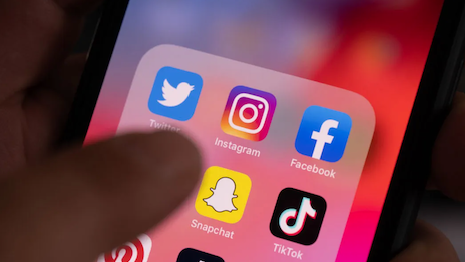A hyperlocal approach is “the next big thing” to hit the retail industry as retailers grapple with how to leverage data analytics and artificial intelligence to deliver improved shopping experiences.
Speaking at the National Retail Federation’s Big Show on Jan. 12, consultants from Capgemini discussed strategies that can be employed to find new ways in which retailers can reach consumers. In response to the new normal triggered by the pandemic, retailers are using technology to adapt to the new landscape and creating more flexible supply chains.
“We’re experiencing just a massive shift in consumer demand and an escalation to online buying like we’ve never experienced before,” said Lindsey Mazza, lead consultant for the global consumer products and retail group at Capgemini, Fort Lauderdale. “Thinking small is the next big thing and we’re going to see a lot of that as 2021 progresses.”
The panel was moderated by Vito Labate, vice president and global industry marketing leader for Capgemini America.
Inventory delivery in focus
Amid one of the largest global crises in history, retailers have been faced with the challenge of getting inventory that is available on a limited basis to the locations where consumers are shopping for it. At the same time, pressure to reduce costs on the supply chain has not diminished.
As a result, businesses are making the shift to being hyperlocal or operating as close to one’s target population as possible since it allows for benefits such as a one- to two-hour delivery window. Micro-fulfillment centers are also all the rage as they allow retailers to leverage existing stores to increase their receptiveness to online orders.
 Retailers want to be as close to their customers as possible. Image credit: Burberry
Retailers want to be as close to their customers as possible. Image credit: Burberry
“It can mean using a store to fulfill or sourcing local products,” Ms. Mazza said. “We have seen just a giant increase in the amount of expectations consumers have around getting the product to them nearly immediately.
“We can get complex with that and build fully robotic fulfillment centers,” she said. “And that’s going to continue to help us reduce costs.”
The quasi-revolution taking place in sales and distribution is an opportunity for retailers to break paradigms and previous boundaries. The new model of supply chain is now being viewed as a supply network where consumers can be met wherever, whenever and however they are shopping.
Consumers are now firmly back at the center of most retailers’ business models in a way where service at a moment’s notice is encouraged.
“This situation allows us to bring new ideas into our companies and take shots we may not have been prompted into otherwise,” Ms. Mazza said. “Retailers are really figuring out how to expand the definition of a supply chain to include the metrics of margin revenue and inventory revenue at the same time.”
In serving its client base, Capgemini’s goal is to predict consumers’ propensity to buy a product based on the attributes that encourage them to do so at a specific point in time.
“Using cognitive computing and the data that we’re able to mine, we can spend more time evaluating those driving attributes,” Ms. Mazza said.
Deciding on which store or distribution center might be the right place from which to launch quick delivery is another approach gaining favor among retailers. Demand forecasting is another issue, as sales history in a year such as this one is unlikely to offer a view of the future.
“The question is how do we combine new things that are happening and how do we react faster to some of the changes that we’re seeing in the marketplace,” said Joyce Chew, smart retail planner delivery consultant at Capgemini, Toronto.
According to the panelists, the so-called social commerce experience, whereby shoppers rely on Facebook, Instagram and other social media sites to influence their buying decisions, is also fundamentally changing demand patterns.
Per Ms. Chew, more connectivity can help consumers make purchase decisions in a more agile manner for clearer demand forecasts.
 Facebook and Instagram play a key role in buying decisions. Image credit: Tinuiti
Facebook and Instagram play a key role in buying decisions. Image credit: Tinuiti
Retailers are also taking a more holistic approach to analytics and attempting to introduce artificial intelligence and data across the full gamut of their networks. A fashion line, for instance, that is approaching the end of a season, could benefit from an automated approach to deciding where to place clothing.
Instant gratification
Affluents turned to online shopping at record levels in 2020, but they still expect to have purchases in hand as soon as possible — one of the benefits of in-store shopping, particularly for luxury goods.
Consumers have embraced retailers’ expanded fulfillment options, including buy-online-pickup-in-store (BOPIS) and curbside pickup, as many remain wary of in-store shopping (see story).
BOPIS and other click-and-collect options will shift from a perk to an expectation for shoppers. However, brands will also be expected to invest in in-store technology that will replicate the online experience.
With deployment of COVID-19 vaccines now underway, shoppers are expected to return to stores — but it is a matter of when and to what extent (see story).
“Being nimble is the way to win,” Ms. Mazza said. “The future is digital and human and the art behind picking the products will not go away.”
{"ct":"64yTkeZP7wGnWCkD3dgdFXPfUZbLZnmj2YkS3cgPZTrFvrimXzztVHqTzM8cU0ZPyYpKGSjGTpgXJrpfA59rqDATirRqjvRY5c6+Kv3K\/nx3kwrybpz4qVhQrYDUos84QZ4JbhVlJq7le9f1KXbt\/dwgvBICLUVyyyOxHCVkjRXZvccQsCV5aCQDXx9zjygwTn5kUNJtxaoyjnwXcT4qcQL1TxcsfLzR18CIMl9DqXZfpDhHJ2nLup2lbEOliEDN1BCf94E\/k0NTjeap4QJcm9wLiwUW7BKKJ3+PbR1b5nR3MqXqPo1gKhwKw+B67u0vmAdgd04AzCOqorSnmWirVJ74q+SWWuVhvcubEyNu9y2TmikQKXrgjzVlxS3cq7BM48oILPfIc1nHBfXowVTQwXjsLbhA26U8dHokupucNdcPWoXvYT6QeGze+Quillf033cjeVy8YgvgXJIfA0LUAml5axiBnnS\/MrpNcC7+PwfA9mhDiTj7B2j+NVZ6\/nR6sJds1Y3RuVdf9nKZJb\/0ripBKpsjt\/+UUmRhryFnnAOzx0ya5evZJxUJq1SCAEiL7x+gRdm2QiVmDnSjfupw7J2wiBwOqB2ELGXh3veu+0XKlXHfcli5ZhpN6D1YpyTQhZxxmGZ25nKaqC04\/Z1GDenbJetiPPVz5iqfcLkmfs2ao9SkUGkpmrdDIm2Od9uHdbp1N1N0bcvNZZ4RU1PQy4m1cqKZ9uV2qF5+5WUr6lPvoyYj+bM2HX3GXu6hH0XxcmRkNkQBwpQjIeGIUo5evhWG1aArCPRM+uwP561bmKaIXcOY6nKeioNWohCnrkACVhOOkGiUj1GofAgs8l8+kP54WAlS94wYgoHwj3U8hSZY+W5gdCkTP1R\/JoElUoMZ3mjplfKeuXvImPj6CGtuzNePXpMXkILAfvqpEjXCG6xUiJtgYOfAdFzqIxDj0zRhS4zyCr+1Rg4uAwkhKgRD7sxvlrpf9Oo4au5HIgQbg92hX9akU0PJfhYVrJIZJNFUoKU8xRD8u\/uUaMGJ6eq1ysbp3b+jHph2QLwW\/vzmiEnZdFvAKuKeIkHl8M296q+lIZJ\/Wh25tH7qTGD7e7txHuDQUvxLTCQv1Lwct5HCLnD0TwD89\/7S5zFbdp+xFztQKCVwLUaHTMkhn28NyNVt4NsahcUw0wIRcYOCMTp1QQF4eCuGsW2w2uExVKhrcF7UXrNaUx5tHPtc2Z2MzYXRD2X9fiASc1YeMJKIiBXscwqLbgkZsAoHhaLn2IpJi6u\/BF7XPnWK6Ip\/U3gWmdWOMx13blv7xP+\/t+L7s0phXw30kZQnNydESTc4QEelklKLoh50xaoqegRWV9l7DXzloBxn9wsSsEtA7m9D20A8RvF18pkCqYM+0lhYeB8Rnoh0BWc2JyXgYM7dlCloHYmtU0SGkYnFbKch1nK0bTIbp6ftTI\/hT58HrEjsrTVjI3uebt3dV2vNgNQ1MRBohU03pS0HyxP03i8jQ\/PBjro6SbKA7KwCUv2exwQ24dNKhTxJ4MHZhdXn3cGJK3QACaQJb8Cx7fFdD\/koZa8NWv2q8WVoNpWkexEaK5xlT\/dz3j4Lvb+jvdXk0RT1ZndvhuwkuB32XTm2EV+hyC9OKzwYJRkkcbLYpl0eRtiSXJoDANkC354owoz3zGD91X7Pfvm0yhqvr7lk5R+z6PUAHJ5Zk2\/HMBO\/y5XCozlypPROA4ofWAyMPACqwPgKzRJCsNbnTr9LU7GKeKU\/bgH7Db0jaMb\/cfYF0+QcnY588BddX50awPEww1VzmHTj3KGanQYziFjRh+F4z5UEsPChVE71jA2vJz+3HdlQI4vpkTTlMQeLued7Y0jm5AT4t6VcPytE9aopBfZ2pQ+x\/j0hk4dW5N2woCUTCdBi1TLZahH3UUnH6iA91JcJ1OqjtgOlC8ZDHjq6Tcxh3xQIaQZGiqz58frlLMcd9LnkAyKZjbtq8H0rPpycSC3YEV+WDchELpfwFT78WzQTad+A\/wcwp25izogGVMFDkmuxWYwgUhJv9mK3oBsyv+iZtVkefIWNJFMeQkw6e78KDDw0\/HpoLJxwwRLE2rUlKIq3R7iByFVdDH88ebm7xdcAe0nT1oXtBrCijyVl22DSpBNZedZBG5+eLigPNPJkzczzwV7sJyFjzTFKthxM0QSlSnv1uiQJk9mLxBjchwCqRR0vzDdAtvhBOgDz4ZpXFnJ904iy0VztMieSDIMNy474lQQMWVSXPdXHCZ+HEvBuhXTfCjsIyr\/2QrloexkrhaPVqr6Z030YMbycFiFLLpKMmojl\/oK5J4GgGkDOnV92nVaH2MJQyXFdKegJyv\/Ntb6zWF7OaBtBrRMcUTqogoQbSbOYZ+pa4QY\/U0B4LNGs7u\/jLGoby43iTfjXqeTpVcypXzOqdYywO86cCz9X8Q9i\/LTnveqhDcELYLMvl9a3HpZjWiNMjXoJTm5lmxhyz9ph+6YYD4PMxyq5ERgV8u1ga0qxczF0u4fTnYpYr4TaWDm69KeNYozlHlk+mR8Koz+8CamvkvOzxWFAafp65buOzZZO9X8U7tRi9ZacaBQLHeAvK5UaO4g3qX2Cz+OPhKKIrQTB0gtJD2GAb4\/k7RwvFAjNn3O1uyNtU14Ur+WYLltYl0w+ve1nVadvNZI\/iwJ+uQicfT+BUZ8\/rt9m2535+iZpNkzGIrfBs2CjXtJRMFQcjrdCpnvIFWN4ytg6uXrRYHzo25bUM2LlNAeTHB7joFA18uAC5SysxAyy3vpF4DnCvnajjItleuU6adhTT3i506Wge8QtqHxr+hvGAFBn7aBWd8mRxdeIiob2ZzC0zCT7TlwatEMQK4\/VjjMqHFzE52GtRgCaZzDh7UoiqyL32ZbYi1AAtpWCc\/nHOA9Uor+uBP66WUxHLVfYoOZCHdP7GZGr6E4t7qOw9\/AHHj\/C6NAnbiXim3EThbMpd63nBBVg4KEW2IL96CBWWqhKny0vBdxyBvuVR6HyW0B9jg85iVruqUw04cKsNo\/C2qP8EXIRLmS04g48li2nRAdcqWC5XPc+tq1CQNe3B81KybfVi31laD\/cgU+vFRQk1Rhnbc\/HxNgNi3vw361BTbkVF7kS5q2PudWlXlXD495sx7wbJQ1vm2wi0CjhDgVVAlhglDp9OfV3Z2CbgExd8eZhgZk3RPh6PtbohOjfi\/Q7L3\/8RK1GEK1PAWII+D7G6bJfD2nQog2MOnUuhehtgGqhbmoZRZetEVtc78Btz1O9E7N91ozqQOK62\/s0mpSLWDkcELdKDE2DmLuhwxWwWtqrnYjct4Xb0XK9673xJw9r+HW3ThT44Xmmzb9MulOgg8GDQ5kIaxbI+ZanAZX2Bzuanjf6nU+ke1Rm6ww5u95YJ7YJ7KZ\/MgOuXEap6MGIIA+MrW+KehohE6V+PJLEoP8KA37C3Y53DcFCrd63AB1MuGDZiCBVGZr7bwrO8MGW1C69CjSB6lo6oK42eChxlSUS4G\/IS\/+r6SCH9h5WRW\/WC5\/4rlRNmEYD3wULtxunerOjnUwdkDmHm+gdeFYbIL6BHl0mvzd2l65v9OuIBjCm2v3Xqbq6YB4tB6OguicB3NFODZ52jBuduhxfBGBOwnmeBBU5PoW3dBm5c7TfTBzq20pTK\/pJ16PiDOqjyJNTZ1alVZlc8ISqI+d6v91Q6OEZuPeb8639m2zwWDLnI7OJQeqGYeOaVqvWOOZSC7EXdF2kdqSp2ng92\/tanGg8bezAWQjo8IRb95AgYaaZ+o1KJP+72lW84DdpfjAFM03nW8gNH1J182T1+I6mVX8OiZ+THXixXxMj6ggt30DfeOAsMtgCO7Fcx3pIhFFaHBy9kqv4O6CzYNruebp6Nu2SmyiHFLxJmWSGqUOHC1Eg3jqiMx7pZxzq38+o+4sOxbzx3nkFV6lVx0zrboWYrVwt4+WFZO38AuMfNaJXy4i7d4WWZbD6MdRtH9Q41gMdG+yhH1RTv+a4zkzyWZXq2rXUYccYOOFptZBy9FZEbZYm9r\/WT6WfZ7W6fuDFHZSEeGh9LtEdakQvkk25u3BiL3LBI3pFpDx6YlwI\/1VWtwElSAY5GLoYTOnaLOWe00FPrNU3GIwiB84BjgLGfkcO8\/UydVO5E8\/wqYf2s7fvbnteONqwgz9Y\/9pTRhTN94jINSKDr3jOuoj+zu9IzPs9aGmLZbMZEa\/bHg8YweSKGDUXkXT6sLgXIzOOyDrGbdByeMvX\/b\/gri\/xuZ+ktUbr7m9nOlf7kcEz2DgHlP1FqI4hNbvP+BRhOdi0gUfTpPkGoaGABvoZomG0X9UG7QldtJasfowp0S4D9fg\/RbU+TYxV9nEH+EHXYqT09MbLWvIGmzujhLdapA1yqs97vBqXTmbF1UV5jkG7OLrgg8fFyh+LQxzfXN6pnWbN9O+NMGn3QOMzx5Tnbz6bxX0EvuMU3lWGbHOVIwXtCzGLNlFyyLO8XmWSSsm02Ei2LRF0eAQ3x98lEvRsEa9oCSmfiFgbrBQibbc2qEiLTP1MSeDa\/VbqfDGZf0G1O9DUiBLOr2b6xSCTQHGYAVvW7CGJfOSt4RjvelqbR4LIMg1Nvz+uzvdLJ\/P2U0zKmKXDeJg0y+bX7XPzCBPxjaivK0Ke5ANM5UJNJugdrBBZBbMkpRrs67q0rIoBoyUtJxn97oF+PRcwiisQHF0TntQqpPp7HqNd2v9yCZPeCLTaYc4D2pAduac1BayIVMtoSz7MjSuUVG7E4aB7TrFjUJm08SOhU2pbJ9L32z4mm3FlnkXpg5nXgmfXaz05I8bnvTqyEkVy0S19y10jml1R9laTJLCTk2\/4HYHkzhxPXkVDXxUrlEdERZSIyA4O8g+twwLoSwOH39cdKb4OOgW31b2bBq4xpv3fQIA+8+jmPK1LgpdFN87mQ3X0nJNilkQkNt4FvaxZxJzz34gG4Lq9qZ808w\/xgVeMSYBD9PLiaDxZhYmLQZbV5E4VHKIfKEZAUFEK2SZI8uuPBsiwEhrRpEkQmbJgWw2hEBXYbqJ9eQm0t1lQD2vu0Pv\/wVqexSIPaY\/kxkDBn4S4\/2xpTPWneWLpbhO1XuQqgiiAfpaXC\/Gu263y5kvFyCLC0c\/fdiH2ItvSERl2x9qQnbq6z5yZl5A66BiWWipDevklvDM+aHpRd9s8fx9YyS6cOOG9H4uK0e3LyA5k9rCGirqTtgYsT\/8Wr1OwxSFxYQ4L\/qgxpG\/1sYqA76iTI5u6cFhw5WZTt32lJxL5qwJCmbmZO3I38\/dMdGcdWtZSrHgbICnxWUzaxDSsiMJDbH6MNmsZbaJBXpYEQ8234+Pa8WZXEvQ7CxiNSrr3yq4POC5GR06SWxim31gNb+WVKqOSrsaqkB8Mv6172sgy0dYFgtWkCZWQ5Lpxj5Ywi8ne\/m22AqV3iCnxMtKa70LaltUv3Fyjg+3DL4QufId9pcdZz+dDeRN5tSTNMv7WZQbkBwhXZ0qQOPF9DU5O8FQPO0FtqjxDZ1qvP324rhHNGbQ19HIt01v0IBe2s1kS20nryAXJERVaEYuLQWmXgvs4os5xDa9oKnEm3WLXcSWbvwY0yiMIZzwp+ogvIdn7iu6RTPOzXFHXckzt+9GTjI3yeuLX2MgSdHeU6WRtVcsQyj2Rwa6q0tiTvYrkx2w9CmhygMRPdvtiYo+Id1Tlb+j6PpyKC4DADRu31yhhfWo8bdw9gjGXAA1V5Y0xAiYBEQWt47GPwIwUy\/7l6mqiPn2k7HyyYtX6tfa\/P9cAWUyKRXiE8fQ9uzwNZOh9ppmtO0Ybsce6TwzIddopuB8iF0Z\/RevPSP1Lm\/IyKc2oxrGzzThdf4TIwMeinaiscVTSa+TCYlfkYZSx5M9lqClrWi813wmLwZR2C310HUTBkm+ElMmS3uSJ7X1\/flegFNGUb0nujYp2VbdBg2NjOVczNQfUZdaYAS853J9JsvvnZfqB4Ti0oIB96aHmpGSrZm2GQahhFgFJi\/gAgRvnpSnaTfAVStsgGzIwVQD5fElJiIypXYAAdu6\/SwZcyQfk+kE9YrpN0R8qfZxw6AIOE8UvQHomC9l95sMiByk+yyI\/sM504niPlkHzJys8yGjvHd5fZ3iTdET0yohWvJmXoCqP0JFweYp6KGZEaamUm6Yfrcyt5IqyhcjTV7tnsyL4kpbCXXz4iYJsZWWY637iTW3sOMWrlK8SlRW6y73pyk3Uy9R38\/C\/rCNREvf\/EXjumuVHMyUVpD5IAhuGUZwHHOcxSuB9CUDSQgVnvG93nYU7DpkxNR+whNLHRGgOwd6DNfynz2Rv0aU6JEHnjPrLWGdVzHY9V0TzfHfhUOMyVl8ShEE8vCRuXavY\/2jI+P7W+nyPCC2bppEvF2bJVskhDz+wnSiU8552glOI+N\/Cj9R6KXHMjwd8KLMEXmDwefj2DOKIN72HurF0+QI6p\/h1KLQxz3Ij3mcS+EdkVME+OnxaqbnwJZzZcx+GQcodEZowcnk84hNiJq10IRYzucAn\/aYnxYExEBSccwdlrC90AD\/0k7Phz1jOtqhAwUSUDuNi+BEYBW7vEWyIkj48foo6fBWzufJY6OuxrOJoa2pXM3Flwu+MoVLMzHOn\/uodQuo77MTX7X8Hs3zkK4elMzx6he4lhgcemDcrJs71w3K\/jqEZi4EP1iUmeHqfmJzaIbMQNz2PxZ7WCQM9oPrinE2QbReboXhAe94BUaDVgYO+k4rneZZQs9Cu2TIuffVFiTlsFWc0EDjZum62I0BgMuMucCYZIFQ6vkUR7m6AqZ9HNtOT6zgB0jskvlHBBxx3YGyj0TY8gbg2RZ7KPMm2kcgwzJmxlfgx49GfRE5t3to+8RLrbjmkH409h1dwEuC5dGxD4UFszfZaLqOAY3gMMOj2w\/Sqxbsp6BPrPL4LowtXyp7SLKoLqlbMxZ+diilB6tOODpLVO01vJSXzQPj7kJ5RDOwZ9XUD2tV4AMSKVB87EofTHrTnlyURWhEPMonxY761+TX+4Ml1gtzm1Q05wFDau9qgSO1jwgobTTVXKNPuDnYFCzlC4\/r2I4zJOyHEWHHFKHUYGmxV6XNSxBRuw7N8f8tV4a2erawfXhYIZf5XulTbxYnLONxR4Fw6tt2FXjsOrq9iB60Gbgp+E7uXeiB5ViZV0cjcSkGOwKQLBM\/\/kpwtFapw3S6wKUTLPKpEdxouOjn+aLA4smhSUM8dk0yIzXX1IhX1981OCdcsIfKP5wTZYhk6y\/\/nh+t6ZzmHIr+7HiYUsxMG\/SYLvKtvjnT8P0oF5Jsh29VJnKV23iv+nrAc20fNm9Q\/q90TluYdcy0m83dc2kJrT5YAslTuRPzcn+XJT5dv4tMnxcYs5vk9ieol0NXS\/30Cd91PHat0aOcazFFj9GOnG8qbkGsgFZskAzJ6FapmoS39VCbzdPJJbpZ5abhMKPcetk7yc+7pVA5eEfQvvoMFKTrseqgIpHfjBOmcMllUYbOqfsDZsyNjhbLwN3an9PKGK6rfocQfyuhOL8GEgKwFRT+1Cqr+8GTWeiACZPI\/cm8kQsFlK7+XJSFdgOJfqMQvLEI1tc+jf8Bi8BuBxFrg0JCPGhHmuxje2SeQf2kBAOjlwSxYq6\/d+kcHxGQAxGfZRxfvKW05IF9fIWDHwR2DFkN+umDqycEw88YtaHIYl3kb03+ufJdqOs9bL9LdLyNb9oAj4SMYjvzDlkqcKORCS5to\/BYbp4qSDNQY2Rr6keRpRsyY3Hsv5+ohngztdZ8DYwz\/ABQh+7qm+M+UnursfwFxgBXVXYAT8AkJrf88aNPoFdNtUVyRVQ\/dmzZXH5AIdY0kF+KRb35GRTiJLhL9diN+hy3njz07Ks5GNWcu832ZeIokwaPg7aQ8TTYMkTlGvaEvFLk0rz4rjwr1MnfLmR87KQaVaHsR3iMQ+PZH50BoG055wakY4FqvlAdmRsM4c9EI0xZ9vk\/FOg74DsaS93o5+xsPMuIen6i+wMdcVktopshfzgByFAgDavNFrXAirpb9k+VjMhR3990Unsh\/Q2bS+hp\/GQeZvL4CDrGwYWM5XEDN7BuNsDxhrbMlaJz7U59BhYnwtE7g6sMwXZGo1pfMVKOw\/RZ7zITNEQ4sOGhP03XTW2vgfq4xkBCnfXSalwi6q3Y7efHZTZ2BkPuq\/FibxsPa5rhuz56sFqnTnXrb+3VITDyeeC9vJQB70cSetQAWlQrqPy9O+NgLxOXHqZxk7xeRnieTs0BVGEW7x14muMtr6NppuZzR99EkHU4xgyZ528LnEqsoHOLVYlczXzPUXQrtx661gdxoeb\/Y6Jjaz2N9wGat2DpdzomhfHLcSF37AffE1dB5\/7IImY3BxFNTiQ1XxP73j5xzxInJ0mScbGr9pciInXqzBNhXBBnnt6sw1K4iHHUHH77eS9zSMZZIFVI33GKFmL5z9pBWEPEjStulYy\/YXTgQ25hjEfDsspjRi1sM6eJmclXy8O6OdmpBIenPapqCnfidU0IN+P0PtGCDI7RIRurpDq4iotDnyOrU\/iV9ejXFB2nA4gJlx949NnAgFz2NdgV7Wpl\/HSmmc76GTPTTPn\/4ThyDFjuhZLaAgPTzI9GG6gSRdWguGdgd\/1IiowA88ALrX21qHhE7I70E8NJXfnV5D7ZD5iw+zsRXuE+mm6LACV3Wl+uiUBethhrao\/Gi77h6q2wyQ4GezJHyKBP26CY9bKC5dOgR16emv9dIJv5q0h3oeJgieG3014Q8mOzqVk4ntJ4bvpeISeKzZjaCJYJ3nTXTDiPbWW+6RPAKma5j0Hcxdun\/E3n+eYCL5poyTD+SfBtO984UYnXrCrbZWdq2Ty\/MHYr12u02f3Ek9fAUlDqftWGMTSRaOeGfsM0OUhBAuqcMG9tnUbIDgnH8M2r3ccecHm2uu6fl0iubKacxDJQeDeG640xH5ujTv\/fTyFnJzUqyRXjvRSs3r6FlU58sNTjW\/UjLh6GeiWOyFUf5F\/5bNDWmIHFZwFxwTgqXaPPPCZlI4BXXmvOrLtO7YefPEk72W6uDknX9t4bNmn8u3woj255wBriAJbtHghIKF6+XniIoI\/UYeYFo7mbhTG4NklpYc5+MnbptA8UyQtaFPLzD\/jYvgwlpk8slHjG3igo44IH0JPv+AqRI0Rl4OtGJDasvVOiFsy7MUlxrFfnnQp6\/etJ9Ksw5vSUOaH7D4CwxKTKsnlsxivQkqiFDVAGUszkd3X8vEHaC108RgmGQORvkIrV+wUJ0wTMHM9TpUJ\/YzqSVgzaG1Tj\/arwxwcYVR4FkTe8wfGevMt7wuwL3lj\/E\/1fAcbr\/TwEhGX1eXBF69lWNV7Kj0bVHFy5yAEIoyQFhClrFNBMh0GpQy2muG2LbpIg5d8q65xO4AuRC1xOnJ2iEceAntWcEGj0bjBeeF9PLcBYGjB7\/Zd9fU0a\/Zfa701cr+PwayddBgTKC4tx2FvSO5j7NjKWBWRSOjXPU6fbwrWdVl0W4uHJ9XnHfcCBYay1lqy+Mya8FU7kVIx6Ou0CkFMjJGPXYqZRns67xWuuVDKk9ualU7PTGkZztap6kyITSNTfr8fMIbRaUmEQDgbueZCBQZqMFjOOfgsQOBTxgKNR72lX9zlQM\/pGTVJuqVw6URLSqy\/gNK9Xo9CypOIhlhD9aUif+ojWZrz\/VLkZtrZ24e1UM01W221dFmoyAHKkwhL4=","iv":"71ed28a4bd3864dd0a711e0426822664","s":"5d4b5b22c51cba93"}

 An instant-gratification style of customer service is now a popular retail trend. Image credit: National Retail Federation
An instant-gratification style of customer service is now a popular retail trend. Image credit: National Retail Federation  Retailers want to be as close to their customers as possible. Image credit: Burberry
Retailers want to be as close to their customers as possible. Image credit: Burberry Facebook and Instagram play a key role in buying decisions. Image credit: Tinuiti
Facebook and Instagram play a key role in buying decisions. Image credit: Tinuiti